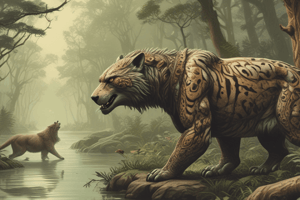Podcast
Questions and Answers
What is the difference between Batesian mimicry and Mullerian mimicry?
What is the difference between Batesian mimicry and Mullerian mimicry?
- Both Batesian and Mullerian mimicry involve two harmful species mimicking each other but with different levels of toxicity.
- Batesian mimicry involves two harmful species mimicking each other, while Mullerian mimicry involves a harmless species mimicking a harmful one.
- Batesian mimicry involves a harmless species mimicking a harmful one, while Mullerian mimicry involves two harmful species mimicking each other. (correct)
- Batesian mimicry involves two harmless species mimicking each other, while Mullerian mimicry involves a harmful species mimicking a harmless one.
What is the competitive exclusion principle?
What is the competitive exclusion principle?
- The competitive exclusion principle states that two species competing for the same limited resource cannot coexist in the same ecological niche. (correct)
- The competitive exclusion principle states that coevolution ensures the survival of multiple species within the same ecological niche.
- The competitive exclusion principle states that two species can coexist in the same ecological niche by sharing resources equally.
- The competitive exclusion principle states that competition between species in different niches leads to higher biodiversity.
What is aposematic coloration?
What is aposematic coloration?
- Aposematic coloration is a form of camouflage used by prey to blend into their environment.
- Aposematic coloration is bright coloration that warns predators of an organism's defenses or toxicity. (correct)
- Aposematic coloration is a strategy where organisms mimic harmful species for protection.
- Aposematic coloration is a type of symbiotic relationship between two species for mutual benefit.
What is niche differentiation and what causes it?
What is niche differentiation and what causes it?
What are community disturbances?
What are community disturbances?
How do species interactions cause coevolution?
How do species interactions cause coevolution?
Which term describes a relationship where one species benefits at the expense of another species without killing it?
Which term describes a relationship where one species benefits at the expense of another species without killing it?
What is the term for the coloration that warns predators of harm or inedibility?
What is the term for the coloration that warns predators of harm or inedibility?
What concept refers to the role of a species within an ecosystem and includes all aspects of its interaction with the biotic and abiotic factors of its environment?
What concept refers to the role of a species within an ecosystem and includes all aspects of its interaction with the biotic and abiotic factors of its environment?
Which term describes the process by which two or more species evolve due to their interactions with each other, leading to mutual adaptations?
Which term describes the process by which two or more species evolve due to their interactions with each other, leading to mutual adaptations?
What is the term for a species that has a disproportionately large effect on its ecosystem relative to its abundance?
What is the term for a species that has a disproportionately large effect on its ecosystem relative to its abundance?
Which type of mimicry involves a harmless species evolving to resemble a harmful or unpalatable species, providing protection?
Which type of mimicry involves a harmless species evolving to resemble a harmful or unpalatable species, providing protection?
Flashcards are hidden until you start studying




